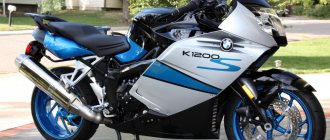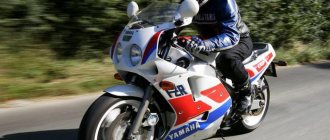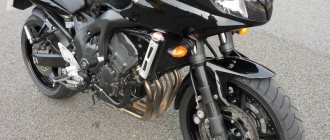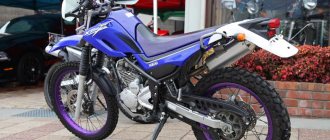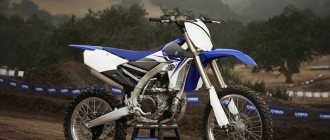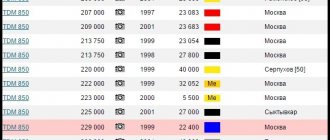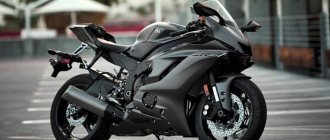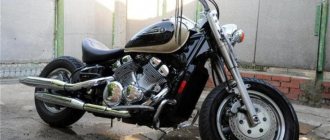Appearing at the end of the last century, the Yamaha R6 motorcycle quickly acquired cult status . It replaced the discontinued Thundercat, a popular but outdated sportbike, and became an excellent choice for those fans of high speeds and adrenaline who do not want to buy a “liter”. Over time, it has undergone many changes and has been repeatedly refined and improved. And don’t let the average cubic capacity deceive you - it is not intended for beginners . This plastic rocket can give you a whole lot of adrenaline, but it's not easy to control.
Design
During numerous upgrades, the Yamaha YZF R6 changed its appearance many times, although its general features remained recognizable. Predatorily narrowed, elongated headlights, a convex windshield, a compact and lean silhouette. Everything changed in 2021, when another restyling was carried out, and the bike became similar to its older brother, the YZF-R1. It must be admitted that, despite a certain loss of individuality, these cosmetic changes did him good, refreshing the design and making it more modern, which is clearly visible from the photo.
A little history
This model was first released in 1999, initially it was presented as the younger brother of the Yamaha R1. The key features of the motorcycle are a 4-cylinder engine with a total volume of 600 cc. cm, excellent traction, 122 hp engine. s., as well as an inverted fork and many other features that are typical for a supersport motorcycle.
Throughout this time, the technical characteristics of the motorcycle were constantly improved: the design was refined and even more comfortable conditions were created for the pilot. So, for example, in 2001-2002. The Yamaha P6 engine could produce only 118 hp. s., and in 2005 the engine had a maximum power of 125 “horses”. After 4 years, the engine could produce about 133.6 hp. With. inertial supercharging.
Specifications
By releasing the 600cc and 1000cc models in parallel, Yamaha engineers applied the most advanced technologies to both of them. The bike turned out to be not only balanced, but also incredibly powerful, and its technical characteristics can put almost anyone to shame. If compromises are not your thing, but a liter sportbike seems too big and heavy for you, the Yamaha YZF R6 will be the perfect option for you.
Engine
The engine that was originally installed in 2001 was slightly modified, and then acquired an injector along with four carburetors. Subsequently, it was modernized several more times, receiving an inertial supercharging system that adds power at high speed, different operating modes and an increased compression ratio. At the same time, the power ultimately did not increase, but even decreased slightly - in the first generation it is 120 hp. , and the latter has 118.4 hp. , and it is achieved at around 13000-14500 rpm . Torque ranges from 68 to 61 Nm , it is available at 10500-12500 rpm, so the engine needs to be constantly revved. Acceleration to 100 km/h takes only 3 seconds! At the same time, the R6's maximum speed is only slightly inferior to that of the YZF-R1, officially amounting to 260 km/h .
Transmission
The modern 6-speed transmission with slipper clutch works perfectly, shifting gears is easy and very precise. At the same time, the gearbox foot has a short stroke, which may at first seem unusual for motorcyclists who have switched from another vehicle. And it’s worth keeping in mind that the YZF-R6 is more demanding when it comes to choosing the right gear than the YZF-R1. After all, how many cubes do they both have? That’s the difference - with a smaller volume, the engine has to be turned more actively, and the gearbox has to be worked more often.
Chassis and brakes
The alloy Deltabox frame with a lightweight swingarm has been changed several times, but on any generation of the motorcycle it is completely consistent with its time. The suspension is fully adjustable both front and rear, and since 2005 an inverted fork has been installed. The brakes are very tenacious, on the front wheel there are two discs (from 298 to 320 mm) with 4-piston calipers , and on the rear there is another 220 mm disc with a 1-piston caliper (on older examples - with a 2-piston caliper). The ABS system is only installed on motorcycles produced in 2017 and younger.
Electronics
Older copies have little electronic filling, but the younger the bike, the more there is. Starting in 2021, there are even more electronics due to the addition of auxiliary traction control systems and selection of engine operating modes. For diagnostics, you need to connect the motorcycle to a laptop with special software via the CAN bus.
Weight and dimensions
The curb weight ranges from 182 to 190 kg , but in any case remains low. Despite its not too low center of gravity, the R6 doesn't feel heavy and is very easy to handle. The compact dimensions also make a positive contribution, thanks to which the bike feels like a fish in water in dense city traffic.
Controllability
All generations of the Yamaha R6 handle superbly, and in the city they feel even more confident than the “liter” ones, thanks to their more modest dimensions and comparable dynamics. In reviews and feedback from owners, complaints arise only about the 2005-2006 models, which, according to pilots, have a tendency to skid the rear wheel during sudden braking.
Fuel consumption
This parameter directly depends on the year of manufacture (more precisely, on the generation) of the motorcycle, its technical condition, operating conditions and riding style. Modern injection R6s from 2018 consume an average of 5.6 liters per 100 km , and for some R6 from 2003 this parameter will be a liter and a half more, especially if you drive aggressively. Tank volume is from 17 to 17.5 liters , depending on the generation.
Design Features
The motorcycle has very good handling, due to which it is able to move with maximum comfort on any road surface, be it a race track, city or dirt road. If desired, you can ride it off-road, as well as along mountain serpentine roads.
The latest model of the 600 is very reminiscent of its liter relative.
When creating a sportbike, the developers took into account all the nuances, so if desired, it can still be used as a motorcycle “for every day . The developers themselves believe that the YZF R6 is similar to a real predator, a tiger that is getting ready to jump. The bike has the epitome of a predator and looks fast on the road.
In the extreme positions of the steering wheel, the wrists rest against the tank pads. For a sportbike this is not a problem, but in the city it causes discomfort.
Despite all the power, this model is lightweight and looks compact . The Japanese manufacturer decided to make the motorbike unique in its own way, and instead of one headlight, used two. This option looks incredibly attractive and aggressive. The optics resemble the slanted, squinted gaze of a predator.
Headlights.
Mirrors with turn signals.
Back light.
Brake system
The braking system is top notch, they have incredible rigidity and are able to stop the motorcycle very effectively.
Front brakes with two discs.
Single disc rear brakes.
The special rigid sports suspension has various adjustments. Excellent handling on long turns is ensured by a heavy-duty aluminum frame.
Landing
The riding position of the motorbike is completely sporty with a maximum forward tilt.
A driver of any height will be comfortable in the saddle, but passengers will have to choose smaller ones.
This arrangement provides good protection from the wind. The dashboard is simple but tasteful. The backlighting of the devices is quite bright, but when exposed to direct sunlight it can reflect, making it difficult to read information from it.
The instrument panel has a black and white tachometer, a battery of color indicator lights and a monochrome display that shows all the information you need, including the selected gear.
Motorcycle price
The cost of the cheapest copies, about 15-20 years old, starts from 180-200 thousand rubles . It is worth keeping in mind that the cheapest offers often have hidden defects, and they need to be checked especially carefully. Well, a completely new Yamaha R6 will cost 1 million rubles and more - these are the current prices at official dealers.
Repair and tuning
How often you will have to spend money on your two-wheeled friend, and how much money will be spent, greatly depends on the operating conditions of the motorcycle. If you drive as usual, then you will spend less, but with regular races on the track, repairs and maintenance will require completely different amounts.
Repair
The Yamaha YZF R6 is not highly maintainable, and many components in it, in the event of a breakdown, can only be replaced and not repaired. This results in the high cost of maintaining the model and the complexity of many service operations. In addition, the latest generations of sport bikes contain a lot of complex electronics, which only experienced mechanics with a laptop and special software can understand. To carry out full diagnostics, you need to connect the “brains” of the bike to a computer and analyze all the data.
Spare parts
The compatibility of spare parts between different generations of a motorcycle is far from 100%, and it is often difficult to find the necessary parts for old Yamaha YuZF R 6. Everything is available to order, but the price may surprise you. But there are few non-original spare parts, despite the popularity of the model and the fact that the market is full of non-original consumables. Their quality ranges from excellent to dismal.
Tuning
The range of available tuning is huge, it includes both cosmetic elements and purely technical ones. Refining the transmission, strengthening the engine, upgrading the brakes - whatever you want, there would be enough money. Moreover, most of this stuff is offered by third-party manufacturers, and not by Yamaha itself.
Motorcycle modifications
The sportbike has changed several times, and now the seventh generation is being sold in dealerships, which will be released in 2021. Below are the main changes to the model by year:
- Yamaha R6 2001. A lot of minor changes to the engine, affecting pistons, connecting rods, ignition and much more. They were considered successful, and the 2002 Yamaha R6 was produced in exactly the same form.
- Yamaha R6 2004 model year (production actually began in 2003) acquired an injector instead of carburetors, as well as an updated appearance.
- Yamaha R6 2006. Another deep restyling with creatively recycled plastic and an engine with increased power (up to 127 hp). The modernization also affected other elements - exhaust, headlight, gas tank, injector and gearbox. The clutch became slippery and the mechanical throttle was replaced with an electronic one. The ignition system has also been completely replaced with a new one. There were some minor flaws, but in the Yamaha R6 2007 they were all corrected.
- In 2008 and 2010, restylings were carried out, but there were no significant changes in the technical part.
- The 2021 Yamaha R6 has received the most profound changes in the model's history. The design was completely redesigned, the bike received a new suspension, stronger brakes, an aerodynamic body kit, auxiliary electronic systems and much more.
A few more words about the bike
This is the first motorcycle with YCC-T, which is controlled by the Yamaha Chip throttle system. In addition, the exhaust pipe greatly facilitates the “breathing” of the motorcycle with the help of a special valve that regulates the direction of the flow of exhaust gases, which, in turn, increases the efficiency of the engine.
The power of a sports motorcycle is fully focused on the final result - stability on sharp turns, ideal tire grip, ease of control and excellent maneuverability, as well as unique body design features that allow the rider to literally merge with the bike into a single whole. Yamaha R6 racing motorcycle - technical characteristics that distinguish the bike from similar 600 cc models, rational operation and reasonable maintenance prices, optimal ratio of engine power to motorcycle weight.
Of course, the Yamaha P6 is the undisputed leader on the race track. Its dynamic character sets the pace and dynamics, and the bright and stylish design will definitely be remembered by everyone who ever sees this bike. The Yamaha R6 is specially created for those who truly value speed and cannot imagine their life without another dose of adrenaline.
Advantages and disadvantages
All generations of the Yamaha R6 differ from each other to one degree or another, but in general the direction of development of this model has not changed for years. This is a super-powerful medium-sized sportbike, its element is the racing track, and all its strengths and weaknesses stem precisely from this circumstance. You don’t expect the comfort of a “Gold Wing” or suspension like some kind of touring bike from racing equipment, do you?
Advantages
- Crazy acceleration dynamics , up to 200 km/h, not inferior to that of the YZF-R1.
- Modest weight , which, coupled with compact dimensions and overall balance, provides excellent maneuverability.
- Unique design , recognizable and very stylish.
- gas tank and long range.
Flaws
- The motorcycle is poorly suited for stunting due to its engine lubrication system. When driving on the rear wheel, it quickly begins to starve of oil, and the engine fails.
- Expensive spare parts , as well as difficulties in finding some of them.
- Low maintainability. Many components cannot be repaired.
- Fragile and expensive plastic .
Motor application
Each model of Yamaha power units differs in its area of application.
The Yamaha 6 CMHS unit is a sports outboard model, which is chosen by both professionals and fishing enthusiasts. The motor can be used to propel an inflatable boat or in a commercial area. There is always a suitable representative in the Standard family.
The Yamaha 6 CMHL power unit is often used for safe navigation in places with shallow depths. In this area, the engine performs well.
The Yamaha F 6 CMHS model is preferable for beginners in the field of fishing. With its help you can travel by simple water transport. In addition, this model is suitable for yacht owners as convenient auxiliary equipment.
Owner reviews
I looked at six hundred sports cars for a long time, and among all the motorcycles I liked the R6 the most. As a result, I bought it, took it from my hands and drove the 2008 R6 to my city, 400 km away. The first impression is as if I saddled a wild mustang, slightly touched the throttle, and that’s it, there was a sharp teleportation forward. At first, sitting after the CBR 600 F4i was wildly uncomfortable; it felt like I was straddling the handle of a shovel. The pendants seemed oak, but then I reconfigured them to suit myself, and it became better. Over time, I got the hang of it, but now the bike is up for sale, I just want a sportbike, but still not so radical, comfort is absolutely lacking. Yuri, Novosibirsk.
Best in class and that's it! This is not the first motorcycle like this for me, first I had a Yamaha R6 2005 (crashed), then an R1 2003 (stolen from the parking lot), then I took the R6 2009, and I still ride it, this is the fourth season. I go to the track sometimes, but only occasionally, I don’t try to improve my lap times, I just ride for fun once a month. And so to work and back every day, plus trips at night and on weekends, everything suits me completely. Vitaly, Moscow.
I own a 2005 Yamaha R6, which, in my opinion, is the most interesting generation of all. It’s not as radical a sportbike as the versions before and after it, there are some distant sports-touring features - the seating is more comfortable, there’s more comfort, so I don’t want to change it to a more recent one. There is one minus, of all generations this is the rarest, so spare parts are difficult to find, only to order, everything is expensive. Well, the plastic is brittle, a slight fall shatters into 100,500 fragments, and the kit stands like an airplane wing. I saw Chinese analogues, but the quality there is very sad. Vadim, Kaluga.
Comparison with analogues
Competitors in this class are the well-known Kawasaki ZX6-R, Suzuki GSX 600 R, Honda CBR 600 RR. The main feature is the slight difference between these motorcycles. This fact is due to performance at racing competitions, the conditions of which strictly shape the characteristics of the equipment.
If we break it down into general impressions regarding our classmates, then the first thing Yamaha is praised for is its clear and predictable handling. A magnesium subframe distinguishes the structure of the frame, while the rest of the representatives have an aluminum alloy.
Similar models
- Honda CBR 600RR. A fresh reincarnation of the famous series, not inferior to its competitors one gram.
- Suzuki GSX-R 600. It has a slightly friendlier and smoother character, which does not make it weaker than its rivals.
- Kawasaki ZX-6R. An incredibly popular model from an “evergreen” manufacturer, with a long history and a whole army of fans.
FAQ
- How noticeable is the difference in dynamics compared to the R1? At speeds up to 150-170 km, the difference is near zero, and it can be attributed to the reaction time of the pilots themselves. At higher speeds, the YZF-R1 begins to confidently pull ahead.
- I want to ride on the track and race at sea in the summer for a couple of thousand kilometers. Is this model right for me? Doubtful, unless you are a masochist. Some people even ride 50cc scooters across Russia, but this bike is not designed for long rides. Most drivers, after several hours behind the wheel, begin to ache in their back and arms, which are subjected to high loads due to a purely sporty riding position.
- Is it possible to turn off assistance systems like traction control? I don’t like it when technology tries to think and make decisions for me. It is possible, but it is not recommended. Japanese engineers are by no means fools, and they installed all this for a reason.
Advantages
The motorcycle steers superbly, easily changes trajectory and shifts at any speed without much effort.
- Excellent handling due to low weight. The bike behaves obediently on any road, but is not suitable for walking around the city.
- The small width of the bike allows you to sit comfortably on a comfortable seat.
- Fuel consumption can be safely called low. During aggressive and harsh driving, a maximum of 8.5 liters of gasoline per 100 kilometers is consumed. Other models of sports motorcycles have significantly higher consumption than these figures.
- Improved suspension consists of a 41mm inverted fork that is fully adjustable. The rear monoshock absorber is also adjustable.
Front adjustable fork.
Rear mono shock absorber.
and disadvantages
- Many motorcyclists will consider it a significant disadvantage no center stand. She is an indispensable assistant when servicing a motorcycle. For example, it is very convenient to use when changing oil, brake pads, chains, rubber and other elements. Therefore, for a sports Yamaha you will have to purchase special tackles. By the way, many models of sport bikes have such shortcomings.
It will be more convenient to carry out motorcycle maintenance on the rolls.
- A significant disadvantage is that the motorbike is not equipped with a fuel indicator . This nuance is unlikely to please the motorcyclist, and in order not to stall in the wrong place without gasoline, you will have to install this device yourself.
- The motorcycle is extremely inconvenient to maintain . To change the oil or spark plugs, you will need to remove the plastic casing, which is secured with special clips. But you will also need to remove the radiator and various fasteners, which are very difficult to detach due to wear. The process of servicing a motorcycle can take quite a long time.
Conclusion
In most cases, “six hundred” cars are deservedly considered less demanding on driving skills than “liters”, but in the case of the Yamaha R6 this is not the case. Its unpredictable character and violent disposition are eloquently demonstrated by the torque curve with dips and pick-ups that can come as a surprise to an inexperienced pilot. To ride this motorcycle, and to do it safely, you need to know how to do it, and skill comes with age. We absolutely cannot recommend this sportbike to beginners . Leave it to experienced pilots who can tame it.
Specifications
| Maximum engine power: | 118.4 – (2018+) HP |
| Torque: | 61.7 Nm (6.3 kg*m) at 10500 rpm – (2017+) Nm |
| Working volume: | 599 cm3 |
| Motor type (cylinder arrangement, number of strokes): | 4-cylinder, 4-stroke, in-line |
| Number of cylinders: | 4 |
| Number of valves: | |
| Intake type (Injector / Carburetor): | |
| Bore and stroke: | |
| Starting system (Electric starter, kick starter): | |
| Maximum speed in km/h: | 260 km/h |
| Cooling system: | Liquid |
| Transmission (gearbox): | 6-speed, Manual |
| Clutch (Dry / Wet): | |
| Drive unit: | Chain |
| Frame: | Aluminum Deltabox |
| Chassis | |
| Suspension (front/rear travel): | |
| Brakes (Front/Rear): | |
| Wheels / Tires / Rubber: | |
| Dimensions and weight | |
| Dimensions (Length / Width): | |
| Seat height: | |
| Ground clearance: | |
| Curb weight: | |
| Wheelbase: | 1375 mm – (2018+) mm |
| Weight: | 190 kg – (2017+) kg |
| Fuel tank capacity: | 17 l. |
| Battery capacity: | |
| Year of release: | |
| Country of Origin: |
Description of the Yamaha YZF-R6 sportbike
A detailed analysis of the characteristics of the Yamaha YUZF R6 bike can be studied below.
Maximum speed and acceleration
The Yamaha P6 accelerates to 100 km/h in 3.2 seconds. The maximum speed of the Yamaha P6 is 277 km/h.
Design Features
The motorcycle is made in the classic style of Japanese sports bikes. Featuring a fetal-shaped fit for maximum streamlining.
Stylish design
The appearance of the Yamaha P6 sportbike is quite aggressive and characteristic of such motorcycles.
Weight and dimensions
The weight of the Yamaha P6 is 166 kg, its length is 204 cm, width – 70.5, height – 110 cm.
The motorcycle is made in the classic style of Japanese sports bikes
